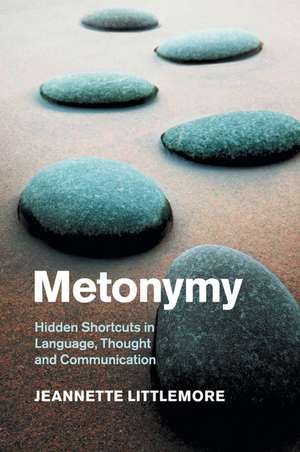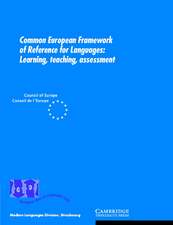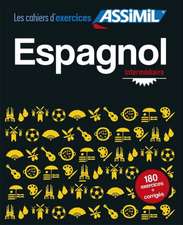Metonymy: Hidden Shortcuts in Language, Thought and Communication: Cambridge Studies in Cognitive Linguistics
Autor Jeannette Littlemoreen Limba Engleză Paperback – 14 mar 2018
| Toate formatele și edițiile | Preț | Express |
|---|---|---|
| Paperback (1) | 282.48 lei 6-8 săpt. | |
| Cambridge University Press – 14 mar 2018 | 282.48 lei 6-8 săpt. | |
| Hardback (1) | 723.60 lei 6-8 săpt. | |
| Cambridge University Press – 28 ian 2015 | 723.60 lei 6-8 săpt. |
Preț: 282.48 lei
Nou
Puncte Express: 424
Preț estimativ în valută:
54.06€ • 56.29$ • 45.69£
54.06€ • 56.29$ • 45.69£
Carte tipărită la comandă
Livrare economică 10-24 martie
Preluare comenzi: 021 569.72.76
Specificații
ISBN-13: 9781108454162
ISBN-10: 110845416X
Pagini: 239
Ilustrații: 5 b/w illus. 1 table
Dimensiuni: 153 x 228 x 14 mm
Greutate: 0.33 kg
Editura: Cambridge University Press
Colecția Cambridge University Press
Seria Cambridge Studies in Cognitive Linguistics
Locul publicării:Cambridge, United Kingdom
ISBN-10: 110845416X
Pagini: 239
Ilustrații: 5 b/w illus. 1 table
Dimensiuni: 153 x 228 x 14 mm
Greutate: 0.33 kg
Editura: Cambridge University Press
Colecția Cambridge University Press
Seria Cambridge Studies in Cognitive Linguistics
Locul publicării:Cambridge, United Kingdom
Cuprins
Introduction; 1. 'What those boys need is a good handbagging'. What is metonymy?; 2. 'He coughed and spluttered a lot and sneezed his lunch all over the place'. Types of metonymy and their behaviour in real-world data; 3. 'He's only bowing to his passport'. Theoretical models of metonymy: uses and drawbacks; 4. ''BBC', her mother would have said'. What do people use metonymy for?; 5. 'But what can we expect, after all, of a man who wears silk underpants?'. Playful, evaluative and creative functions of metonymy; 6. 'The Government of Britain is sort of there'. How can we identify 'metonymy'?; 7. 'I found Robbie Williams in the lounge'. How is metonymy processed in the mind?; 8. 'He started as nobody from Austria'. Cross-linguistic and cross-cultural variation in metonymy: implications for language learning and translation; 9. 'These huts did absolutely unbelievable work'. What do we now know about metonymy?
Recenzii
'Jeannette Littlemore's book exposes the role of metonymy in all fields of life, from everyday language to the arts. A comprehensive, insightful, and engaging treatment of a fundamental cognitive mechanism.' Frank Boers, Victoria University of Wellington
'From a cognitive-linguistic perspective, this book explores multiple theoretical and applied aspects of metonymy. With a clear and lucid style, Littlemore offers her readers a firmly integrated landscape that masterfully balances breadth of scope and analytical detail.' Francisco Ruiz de Mendoza, University of La Rioja
'For a long time metonymy has remained the neglected sibling of metaphor, but Jeannette Littlemore now elegantly shows what we have missed. This book offers an encompassing and lucid overview of what contemporary researchers need to take into account when they address metonymy as an essential tool in language, thought, and communication. It strikes a dearly needed balance between theory, data, and relations to metonymy use in the real world and it may justly act as a programmatic frame for future research.' Gerard Steen, VU University Amsterdam
'Jeannette Littlemore's monograph shows conclusively that metonymy is a cognitively grounded phenomenon that is as pervasive, and probably even more fundamental, than conceptual metaphor in shaping language structure and use. The author provides an impressive state-of-the-art overview of current research, unsurpassed in its breadth and analytic depth … A most welcome feature of the book is that the author demonstrates the significance and the workings of metonymy in sign language, literature, the arts, film, music, advertising, intercultural communication, and language learning. Moving beyond a purely conceptual analysis, Littlemore also critically assesses the pragmatic and socio-cognitive effects of metonymy, demonstrating its sometimes dehumanizing effects. For years to come, this engagingly written and reader-friendly book will be a source of reference and inspiration for students and scholars alike and will boost innovative research on figurative language and thought.' Klaus-Uwe Panther, Nanjing Normal University and University of Hamburg
'Jeannette Littlemore's new book beautifully explains the complex workings of metonymy, how it differs from, yet interacts with, metaphor, how people acquire the facility to use metonymy, understand it, and employ it in diverse social and cultural situations. No single volume has ever provided this amazing breadth of material on metonymy, which is why this book will be an instant classic within figurative language scholarship.' Raymond W. Gibbs, Jr, University of California, Santa Cruz
'Until recently, metonymy studies had to be content with playing second fiddle to metaphor analysis, both in terms of theoretical status and methodological applications. Littlemore's brilliant book puts paid to this tradition by giving a succinct overview over the advances in cognitive modelling of metonymy production, identification, comprehension and usage, as well providing fascinating insights into the interplay of metaphor and metonymy in real-world contexts, including political, therapeutic, pedagogic and intercultural communication.' Andreas Musolff, University of East Anglia
'From a cognitive-linguistic perspective, this book explores multiple theoretical and applied aspects of metonymy. With a clear and lucid style, Littlemore offers her readers a firmly integrated landscape that masterfully balances breadth of scope and analytical detail.' Francisco Ruiz de Mendoza, University of La Rioja
'For a long time metonymy has remained the neglected sibling of metaphor, but Jeannette Littlemore now elegantly shows what we have missed. This book offers an encompassing and lucid overview of what contemporary researchers need to take into account when they address metonymy as an essential tool in language, thought, and communication. It strikes a dearly needed balance between theory, data, and relations to metonymy use in the real world and it may justly act as a programmatic frame for future research.' Gerard Steen, VU University Amsterdam
'Jeannette Littlemore's monograph shows conclusively that metonymy is a cognitively grounded phenomenon that is as pervasive, and probably even more fundamental, than conceptual metaphor in shaping language structure and use. The author provides an impressive state-of-the-art overview of current research, unsurpassed in its breadth and analytic depth … A most welcome feature of the book is that the author demonstrates the significance and the workings of metonymy in sign language, literature, the arts, film, music, advertising, intercultural communication, and language learning. Moving beyond a purely conceptual analysis, Littlemore also critically assesses the pragmatic and socio-cognitive effects of metonymy, demonstrating its sometimes dehumanizing effects. For years to come, this engagingly written and reader-friendly book will be a source of reference and inspiration for students and scholars alike and will boost innovative research on figurative language and thought.' Klaus-Uwe Panther, Nanjing Normal University and University of Hamburg
'Jeannette Littlemore's new book beautifully explains the complex workings of metonymy, how it differs from, yet interacts with, metaphor, how people acquire the facility to use metonymy, understand it, and employ it in diverse social and cultural situations. No single volume has ever provided this amazing breadth of material on metonymy, which is why this book will be an instant classic within figurative language scholarship.' Raymond W. Gibbs, Jr, University of California, Santa Cruz
'Until recently, metonymy studies had to be content with playing second fiddle to metaphor analysis, both in terms of theoretical status and methodological applications. Littlemore's brilliant book puts paid to this tradition by giving a succinct overview over the advances in cognitive modelling of metonymy production, identification, comprehension and usage, as well providing fascinating insights into the interplay of metaphor and metonymy in real-world contexts, including political, therapeutic, pedagogic and intercultural communication.' Andreas Musolff, University of East Anglia
Notă biografică
Descriere
This book explores metonymy in language, gesture, music, art and film, and discusses the challenges it presents in cross-cultural communication.













